
The Enchanting Casco Histórico of Santiago de Compostela
Discover the historic charm and vibrant culture of Casco Histórico in Santiago de Compostela, where medieval streets, iconic landmarks, and culinary delights await.
Stepping into the Casco Histórico of Santiago de Compostela is like taking a journey back in time. This historic quarter is the beating heart of the city, renowned for its cobblestone streets, ancient architecture, and vibrant atmosphere. As you wander through its lanes, you'll be captivated by the blend of medieval and baroque structures, each telling a story of a bygone era. At the center of Casco Histórico lies the magnificent Santiago de Compostela Cathedral, a UNESCO World Heritage site and the final destination of the famous Camino de Santiago pilgrimage. The cathedral's grand facade and intricate interior are a testament to centuries of craftsmanship and devotion. Nearby, the Plaza del Obradoiro serves as a bustling hub where pilgrims and tourists alike gather to soak in the historic ambiance. The neighbourhood is also home to numerous charming squares, such as the Plaza de la Quintana and the Plaza de las Platerías, where you can relax at a café and watch the world go by. Don't miss the chance to explore the local markets, boutique shops, and traditional Galician restaurants that dot the area. Here, you can savor regional delicacies like pulpo a la gallega (Galician octopus) and empanada. Casco Histórico is not just about history; it also offers a rich cultural experience. Throughout the year, the streets come alive with festivals, music, and art, making it a dynamic and lively place to visit. Whether you are a history buff, a foodie, or simply looking to immerse yourself in the local culture, the Casco Histórico of Santiago de Compostela promises a memorable and enriching experience.
Local tips in Casco Histórico
- Wear comfortable shoes as the cobblestone streets can be uneven and require good footwear.
- Visit the Cathedral early in the morning or late in the afternoon to avoid the largest crowds.
- Try to learn a few basic phrases in Spanish or Galician; locals appreciate the effort.
- Check the local festival calendar to experience traditional Galician festivities.
- Carry some cash, as smaller shops and restaurants may not accept credit cards.
The Enchanting Casco Histórico of Santiago de Compostela
Stepping into the Casco Histórico of Santiago de Compostela is like taking a journey back in time. This historic quarter is the beating heart of the city, renowned for its cobblestone streets, ancient architecture, and vibrant atmosphere. As you wander through its lanes, you'll be captivated by the blend of medieval and baroque structures, each telling a story of a bygone era. At the center of Casco Histórico lies the magnificent Santiago de Compostela Cathedral, a UNESCO World Heritage site and the final destination of the famous Camino de Santiago pilgrimage. The cathedral's grand facade and intricate interior are a testament to centuries of craftsmanship and devotion. Nearby, the Plaza del Obradoiro serves as a bustling hub where pilgrims and tourists alike gather to soak in the historic ambiance. The neighbourhood is also home to numerous charming squares, such as the Plaza de la Quintana and the Plaza de las Platerías, where you can relax at a café and watch the world go by. Don't miss the chance to explore the local markets, boutique shops, and traditional Galician restaurants that dot the area. Here, you can savor regional delicacies like pulpo a la gallega (Galician octopus) and empanada. Casco Histórico is not just about history; it also offers a rich cultural experience. Throughout the year, the streets come alive with festivals, music, and art, making it a dynamic and lively place to visit. Whether you are a history buff, a foodie, or simply looking to immerse yourself in the local culture, the Casco Histórico of Santiago de Compostela promises a memorable and enriching experience.
Iconic landmarks you can’t miss
Parque da Alameda (Santiago de Compostela)
Experience the tranquility and beauty of Parque da Alameda, a serene park offering stunning views and lush gardens in Santiago de Compostela.

Praza da Quintana de Vivos
Experience the vibrant history and cultural charm of Praza da Quintana de Vivos, a must-see landmark in Santiago de Compostela.
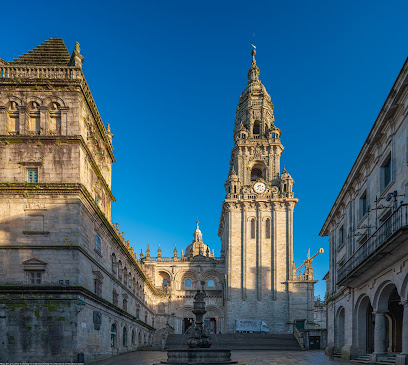
Porch of the Glory
Discover the artistry and historical significance of the stunning Porch of the Glory at Santiago de Compostela's iconic cathedral, a must-see for every traveler.

Miradoiro da Catedral
Experience breathtaking views of Santiago de Compostela at the Miradoiro da Catedral, where history and beauty converge in a picturesque setting.

Obradoiro Square
Discover the breathtaking Obradoiro Square, a historical landmark in Santiago de Compostela, surrounded by stunning architecture and vibrant culture.

Fountain of Horses
Explore the enchanting Fountain of Horses, a historical landmark in Santiago de Compostela, where art and history come together in a vibrant plaza.

Fonte do Toural
Experience the heart of Santiago de Compostela at Fonte do Toural, a historical landmark blending culture, charm, and local life.

Porta Santa da Catedral de Santiago de Compostela
Discover the beauty and spiritual essence of the Porta Santa at Santiago de Compostela, a historical landmark that embodies centuries of pilgrimage.

centro histórico Santiago de compostela
Discover the enchanting historic center of Santiago de Compostela, a UNESCO World Heritage site rich in history, culture, and culinary delights.

Concha de Santiago
Discover the Concha de Santiago, an architectural gem in Santiago de Compostela, where history and beauty meet in a captivating landmark.

Unmissable attractions to see
Porch of the Glory
Explore the breathtaking Porch of the Glory at Santiago de Compostela Cathedral, a stunning Baroque masterpiece rich in history and spirituality.

Cathedral Museum
Explore the Cathedral Museum in Santiago de Compostela, a treasure trove of sacred art and history that brings the cathedral's rich heritage to life.

Obradoiro Square
Discover the architectural splendor and vibrant culture of Obradoiro Square, the historical heart of Santiago de Compostela.

Casa do Deán
Explore Casa do Deán, a stunning architectural gem in Santiago de Compostela, perfect for history and culture enthusiasts alike.

Campás de San Xoán
Experience the rich history and architectural beauty of Campás de San Xoán in Santiago de Compostela, a serene tourist attraction steeped in culture.

Essential places to dine
Casa Manolo
Discover authentic Galician flavors at Casa Manolo in Santiago de Compostela's historic Plaza de Cervantes.

A Taberna do Bispo
Experience authentic Galician tapas at A Taberna do Bispo—where tradition meets flavor in the heart of Santiago de Compostela.

Mesón 42
Savor authentic Galician cuisine at Mesón 42 in Santiago de Compostela's historic district - where tradition meets flavor.
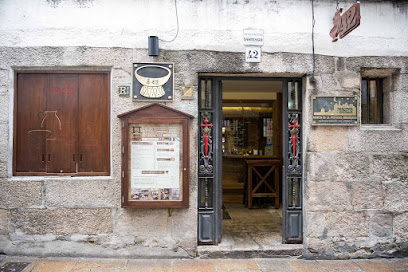
El Papatorio
Discover El Papatorio: A culinary delight in Santiago de Compostela offering traditional Galician dishes with a modern twist.

Casa de Xantar O Dezaseis (Santiago de Compostela)
Experience authentic Galician cuisine at Casa de Xantar O Dezaseis in Santiago de Compostela – where tradition meets flavor.

Casa Marcelo
Experience the exquisite fusion of Galician, Japanese, and Mediterranean cuisines at Casa Marcelo in Santiago de Compostela.

O Sendeiro
Experience authentic Galician cuisine at O Sendeiro in Santiago de Compostela - where every dish tells a story of tradition and flavor.

Restaurante A Maceta
Experience authentic Mediterranean cuisine in Santiago de Compostela at Restaurante A Maceta - where local flavors meet culinary excellence.

A Horta d'Obradoiro
Experience authentic Galician cuisine at A Horta d'Obradoiro in Santiago de Compostela - where tradition meets flavor.
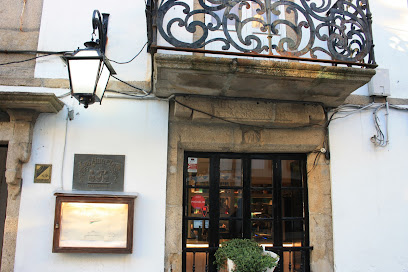
Curro da Parra
Experience authentic Mediterranean cuisine at Curro da Parra, renowned for its delicious tapas and inviting atmosphere in Santiago de Compostela.
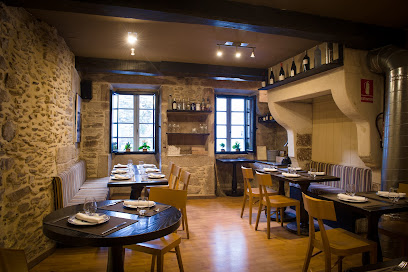
Markets, malls and hidden boutiques
Área Central Shopping mall
Discover a shopping paradise at Área Central Shopping Mall in Santiago de Compostela, where retail therapy meets culinary delights and entertainment options.

Cultura Urbana Shop
Explore the vibrant fashion scene at Cultura Urbana Shop, your go-to destination for youth clothing, accessories, and skate gear in Santiago de Compostela.

Natura
Explore Natura in Santiago de Compostela: A treasure trove of local gifts, clothing, and home goods that embodies the spirit of Galicia.

Sargadelos Galería Santiago
Discover the beauty of Galician artistry at Sargadelos Galería Santiago, home to exquisite handmade chinaware and contemporary art.

TRISQUEL ARTESANÍA
Discover the vibrant world of Galician handicrafts at Trisquel Artesanía, your gateway to unique jewelry, clothing, and local artistry in Santiago de Compostela.

Pilgrim Bag
Explore unique and customizable handbags at Pilgrim Bag, a must-visit shop in the heart of Santiago de Compostela, embracing creativity and craftsmanship.
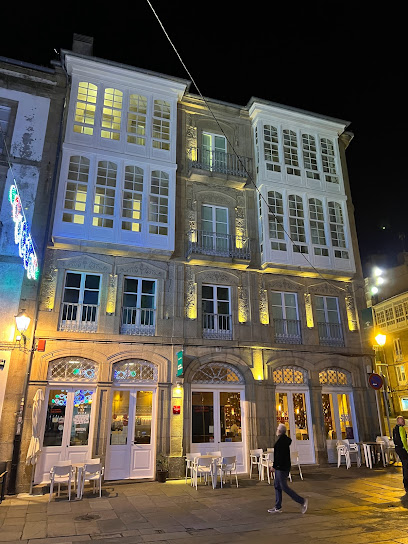
Recuerdos Obradoiro
Explore Recuerdos Obradoiro, a charming gift shop in Santiago de Compostela, for authentic Galician souvenirs and unique keepsakes.

Merlín e Familia
Discover Merlín e Familia, the quintessential store for artistic handicrafts in Santiago de Compostela, showcasing the rich culture of Galicia.

Souvenirs As 5 Ruas
Discover unique local crafts and authentic mementos at Souvenirs As 5 Ruas in Santiago de Compostela, a must-visit for every traveler.

Souvenir Corticela
Discover authentic Galician crafts and local delicacies at Souvenir Corticela in Santiago de Compostela, perfect for memorable keepsakes.

Essential bars & hidden hideouts
Pub Momo
Discover the vibrant charm of Pub Momo, a top pub in Santiago de Compostela known for its lively atmosphere and diverse drink offerings.

Bar A Novena Porta
Experience the excitement of sports in a traditional Galician setting at Bar A Novena Porta, Santiago de Compostela's beloved sports bar.

Pub Atlántico (Santiago de Compostela)
Experience the vibrant nightlife of Santiago de Compostela at Pub Atlántico, a cocktail bar and rock music club in the city's historic center.

Rock Café O Cum (Santiago de Compostela)
Experience the vibrant nightlife of Santiago de Compostela at Rock Café O Cum, where live music and local culture create unforgettable moments.

Pub Lucille (Santiago de Compostela)
Experience the vibrant atmosphere of Pub Lucille in Santiago de Compostela, a cozy pub offering local drinks and delicious tapas in a historic setting.

A Medusa Pub (Santiago de Compostela)
Discover A Medusa Pub: a vibrant spot in Santiago de Compostela offering local drinks, live music, and a cozy atmosphere in the heart of the historic district.

Pub Século IX
Discover the lively charm of Pub Século IX, a favorite gathering spot in Santiago de Compostela, offering a vibrant atmosphere and diverse drink selection.
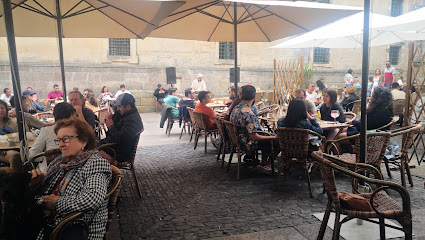
Embora Bar Musical
Experience the vibrant nightlife of Santiago de Compostela at Embora Bar Musical, where live music and great drinks create unforgettable memories.

O Boneco Bar (Santiago de Compostela)
Experience the vibrant nightlife of Santiago de Compostela at O Boneco Bar, where great music and affordable drinks await you.

Bar Forest
Discover the charm of Bar Forest in Santiago de Compostela, where local flavors and a friendly atmosphere await every traveler.

Local Phrases
-
- HelloHola
[oh-la] - GoodbyeAdiós
[ah-dee-ohs] - YesSí
[see] - NoNo
[noh] - Please/You're welcomePor favor/De nada
[por fah-bor/de nah-dah] - Thank youGracias
[grah-thyahs] - Excuse me/SorryPerdón/Lo siento
[pair-dohn/loh syen-toh] - How are you?¿Cómo estás?
[koh-moh ehs-tahs] - Fine. And you?Bien. ¿Y tú?
[byen. ee too] - Do you speak English?¿Hablas inglés?
[ah-blahs een-glays] - I don't understandNo entiendo
[noh ehn-tyen-doh]
- HelloHola
-
- I'd like to see the menu, pleaseQuisiera ver la carta, por favor
[kee-syeh-rah behr lah kahr-tah, por fah-bor] - I don't eat meatNo como carne
[noh koh-moh kahr-neh] - Cheers!¡Salud!
[sah-loohd] - I would like to pay, pleaseMe gustaría pagar, por favor
[meh goos-tah-ree-ah pah-gar, por fah-bor]
- I'd like to see the menu, pleaseQuisiera ver la carta, por favor
-
- Help!¡Ayuda!
[ah-yoo-dah] - Go away!¡Vete!
[veh-teh] - Call the Police!¡Llama a la Policía!
[yah-mah ah lah poh-lee-see-ah] - Call a doctor!¡Llama a un médico!
[yah-mah ah oon meh-dee-koh] - I'm lostEstoy perdido/a
[ehs-toy pair-dee-doh/ah] - I'm illEstoy enfermo/a
[ehs-toy ehn-fehr-moh/ah]
- Help!¡Ayuda!
-
- I'd like to buy...Me gustaría comprar...
[meh goos-tah-ree-ah kohm-prahr] - I'm just lookingSolo estoy mirando
[soh-loh ehs-toy meer-ahn-doh] - How much is it?¿Cuánto cuesta?
[kwan-toh kwehs-tah] - That's too expensiveEsto es demasiado caro
[ehs-toh ehs deh-mah-syah-doh kah-roh] - Can you lower the price?¿Puede bajar el precio?
[pweh-deh bah-hahr ehl pree-syoh]
- I'd like to buy...Me gustaría comprar...
-
- What time is it?¿Qué hora es?
[keh o-rah ehs] - It's one o'clockEs la una
[ehs lah oo-nah] - Half past (10)Y media (10)
[ee meh-dee-ah (dee-ehs)] - MorningMañana
[mah-nyah-nah] - AfternoonTarde
[tahr-deh] - EveningNoche
[noh-cheh] - YesterdayAyer
[ah-yehr] - TodayHoy
[oy] - TomorrowMañana
[mah-nyah-nah] - 1Uno
[oo-noh] - 2Dos
[dohs] - 3Tres
[trehs] - 4Cuatro
[kwa-troh] - 5Cinco
[seen-koh] - 6Seis
[says] - 7Siete
[syeh-teh] - 8Ocho
[oh-choh] - 9Nueve
[nweh-veh] - 10Diez
[dyehth]
- What time is it?¿Qué hora es?
-
- Where's a/the...?¿Dónde está el/la...?
[dohn-deh ehs-tah ehl/lah] - What's the address?¿Cuál es la dirección?
[kwal ehs lah dee-rek-syon] - Can you show me (on the map)?¿Puedes enseñarme (en el mapa)?
[pweh-dehs ehn-seh-nyar-meh (ehn ehl mah-pah)] - When's the next (bus)?¿Cuándo es el próximo (autobús)?
[kwan-doh ehs ehl proh-ksee-moh (ow-toh-boos)] - A ticket (to ....)Un billete (a ....)
[oon bee-yeh-teh (ah)]
- Where's a/the...?¿Dónde está el/la...?
History of Casco Histórico
-
The area of Casco Histórico is deeply intertwined with the history of Santiago de Compostela, which became a pilgrimage hub after the discovery of the tomb of St. James in the 9th century. The historic neighborhood began to take shape as a settlement for pilgrims and clergy, leading to the establishment of significant religious and civil structures.
-
During the 11th to 15th centuries, Casco Histórico witnessed a remarkable architectural flourishing, characterized by Romanesque and Gothic styles. The iconic Santiago de Compostela Cathedral, a UNESCO World Heritage Site, was constructed during this period, becoming a focal point of the neighborhood and the city itself.
-
With the rise of the Camino de Santiago in the Middle Ages, Casco Histórico served as the main entry point for pilgrims. Its streets buzzed with activity as travelers from across Europe gathered to pay homage at the cathedral. This influx contributed to the cultural and economic growth of the neighborhood, fostering a diverse and vibrant community.
-
In the 17th and 18th centuries, the neighborhood underwent significant changes as Baroque architecture became prevalent. Buildings such as the Convent of San Francisco and the Casa da Parra were constructed, reflecting the wealth generated by the thriving pilgrimage economy and the influence of the Catholic Church.
-
The 19th century brought industrialization to Santiago de Compostela, impacting Casco Histórico as well. The expansion of the railway and the development of infrastructure led to urban changes, while the historic center remained a vital cultural and political hub of the city.
-
In the late 20th century, efforts to preserve the historical integrity of Casco Histórico intensified. Recognizing its significance as a cultural heritage site, local authorities and organizations worked to restore and maintain its architecture, leading to a renewed interest in the area's history and its role in the Santiago de Compostela narrative.
Casco Histórico Essentials
-
Casco Histórico is centrally located in Santiago de Compostela, making it easily accessible from other neighborhoods. If you're coming from the train station (Estación de Tren), a short 20-minute walk will take you through the charming streets to the heart of the historic area. Buses from various neighborhoods also connect to the main square, Plaza del Obradoiro, which is the focal point of Casco Histórico. Taxis are available throughout the city and can drop you off at various points within the neighborhood.
-
Casco Histórico is primarily pedestrian-friendly, encouraging visitors to explore on foot. The main attractions are within walking distance, making it easy to navigate the narrow, winding streets. There are no trains or buses operating within this area due to its compact size. Bicycles can be rented from nearby shops, and some streets have bike lanes for those who prefer cycling. For longer distances, taxis are readily available.
-
Casco Histórico is generally safe for tourists, but standard precautions should be observed. Avoid poorly lit areas at night and keep your belongings secure, especially in crowded spots like markets or popular tourist attractions. While violent crime is rare, petty theft can occur in busy areas. Areas around the fringes of the neighborhood, especially toward the outskirts, may have higher crime rates, so it's wise to remain vigilant.
-
In case of an emergency, dial 112 for immediate assistance. This number covers police, fire, and medical emergencies. The local hospital, Hospital Clínico Universitario de Santiago, provides comprehensive medical services and is located just outside the Casco Histórico. Pharmacies are also available throughout the area for minor health concerns. It is advisable to have travel insurance that covers medical emergencies.
-
Fashion: Do dress modestly and comfortably, especially when visiting churches. Avoid wearing beachwear or overly casual attire. Religion: Do respect local customs, especially in sacred places. Always be quiet and respectful inside churches. Public Transport: Do be courteous and offer your seat to the elderly or those in need. Don't consume food or drink on public transportation. Greetings: Do greet locals with a friendly 'Hola' and a smile. Avoid being overly loud or intrusive. Eating & Drinking: Do try local dishes such as octopus (pulpo) and Galician wine. Don't waste food; it is considered disrespectful to leave meals unfinished.
-
To experience Casco Histórico like a local, visit the Mercado de Abastos, where you can taste fresh produce and local delicacies. Enjoy a coffee at one of the many small cafes and take your time to soak in the atmosphere. Participate in the traditional tapas culture by hopping between bars to sample different dishes. Engage with locals and don't hesitate to ask for recommendations; they are often eager to share their favorite spots. For a unique experience, try to catch a local festival or market day.
Trending Landmarks in Casco Histórico
Nearby Cities to Casco Histórico
-
Things To Do in Ponte de Lima
-
Things To Do in Viana do Castelo
-
Things To Do in Braga
-
Things To Do in Chaves
-
Things To Do in Guimarães
-
Things To Do in Vila Real
-
Things To Do in Bragança
-
Things To Do in Porto
-
Things To Do in Lamego
-
Things To Do in Oviedo
-
Things To Do in Aveiro
-
Things To Do in Coimbra
-
Things To Do in Salamanca
-
Things To Do in Valladolid
-
Things To Do in Tomar













